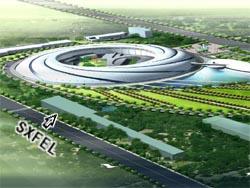
A scheme map of SXFEL at the campus of the Shanghai Synchrotron Radiation Facility.
CAS has decided to establish, as pre-research engineering projects for a hard X-ray free-electron laser (FEL) facility in the future, a soft X-ray FEL (SXFEL) experiment facility and an RF superconducting accelerator unit, according to a presentation made by Prof. ZHAO Zhentang, vice director-general of the CAS Shanghai Institute of Applied Physics (SINAP), at the 122nd session of the Eastern Forum of Science and Technology held on 11 and 12 December in Shanghai.
Using a relativistic electron beam as its working medium, FEL is a new kind of laser source that amplifies electromagnetic radiation via stimulated emissions in a periodic magnetic field. It is considered as an operational technical approach to the fourth-generation light sources as it has the widest frequency range of any laser type with high brightness and short pulses, and can be widely tunable.
Key technologies concerning the development of hard X-ray FEL facilities are highly challenging and very expensive. Therefore, all of the three such facilities now under construction in the world (LCLS in US, EURO-XFEL in Europe, and SCSS in Japan), were started with soft X-ray FEL.
A study on FEL test facility was initiated by a group of the CAS Institute of High Energy Physics (IHEP) in 2005, and such a kind of FEL R&D had been proposed by Prof. C. N. Yang, 1957 Nobel laureate in physics, in 1997, according to Prof. ZHAO, who is vice principal investigator of a research project on FEL with support from the National Basic Research Program.
After long discussions within the experts in Chinese physics community, CAS decided in 2007 to choose the Shanghai Synchrotron Radiation Facility campus as the facility site of SXFEL test facility and SINAP as its host institute. Its design and construction will be implemented under the close collaborations among IHEP, Tsinghua University and SINAP. Right now, a proposal for SXFEL is under the government's review.
The future SXFEL will be a 10nm two-stage cascading high gain and harmonic generation (HGHG) FEL demonstrator for performing the "proof of principle" of the cascading HGHG FEL and prototyping the key FEL technologies toward the HGHG based X-ray FEL, notes Prof. Zhao.
Related News
Photos
More>>trade
- CAS Academician Chen Zhu Nominated ''People to Watch in 2009''
- China's Second National Assessment Report on Climate Change Being Drafted
- Shenzhou-7's monitor satellite finishes mission after 100 days in space
- The first ''Quantum Repeater'' chosen as the ''Best of 2008''
- New green super rice expected in 10 years
market
finance
- CAS to further cooperation with German academia in ocean studies
- Construction of largest aperture radio telescope starts in southwest China
- Premier urges scientists to help fight financial crisis
- CAS researchers receive TAN Jiazhen Awards for Life Sciences
- China's Think Tank Forecasts 8.3% GDP Growth in 2009





